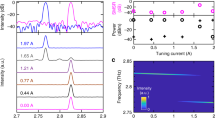Abstract
We study both theoretically and experimentally typical operation regimes of 40 GHz monolithic mode-locked lasers. The underlying Traveling Wave Equation model reveals quantitative agreement for characteristics of the fundamental mode-locking as pulse width and repetition frequency tuning, as well as qualitative agreement with the experiments for other dynamic regimes. Especially the appearance of stable harmonic mode-locking at 80 GHz has been predicted theoretically and confirmed by measurements. Furthermore, we derive and apply a simplified Delay-Differential-Equation model which guides us to a qualitative analysis of bifurcations responsible for the appearance and the breakup of different mode-locking regimes. Higher harmonics of mode-locking are predicted by this model as well.
Similar content being viewed by others
References
Avrutin, E., V. Nikolaev and D. Gallagher. Optoelectronic Devices: Advanced Simulation and Analysis, chapter 7: Monolithic Mode-Locked Semiconductor Lasers, p. 185–215. J. Piprek, 2005.
U. Bandelow M. Radziunas J. Sieber M. Wolfrum (2001) IEEE J. Quantum Electron 37 IssueID2 183–188 Occurrence Handle10.1109/3.903067
U. Bandelow H. Wenzel H.-J. Wünsche (1992) Electron. Lett. 28 1324–1326
Engelborghs, K., T. Luzyanina and G. Samaey. DDE-BIFTOOL v. 2.00: A matlab package for bifurcation analysis of delay differential equations. Technical Report TW-330, Department of Computer Science, K.U. Leuven, Leuven, Belgium, 2001.
Guglielmi, N. and E. Hairer. Users’ Guide for the Code RADAR5, 2000.
H. Haus (2001) IEEE J. Sel. Top Quantum Electron 6 1173–1185 Occurrence Handle10.1109/2944.902165 Occurrence Handle2001LNP...579.....H
R. Kaiser B. Hüttl H. Heidrich S. Fidorra W. Rehbein H. Stolpe R. Stenzel W. Ebert G. Sahin (2003) IEEE Photon Technol. Lett 15 IssueID5 634–636 Occurrence Handle10.1109/LPT.2003.809924
G.H.C. New (1974) IEEE J. Quantum Electron 10 115–124 Occurrence Handle10.1109/JQE.1974.1145781
Rachinskii, D. and A. Vladimirov. Q-switching instability in a mode-locked semiconductor laser. WIAS preprint 975, 2004.
Radziunas, M., H.-J. Wünsche, B. Sartorius, O. Brox, D. Hoffmann, K. Schneider and D. Marcenac. Optoelectronic Devices: Advanced Simulation and Analysis, chapter 5: Multisection Lasers: Longitudinal Modes and their Dynamics, pp. 121–150. J. Piprek, 2005.
A. Vladimirov D. Turaev G. Kozyreff (2004) Opt. Lett 29 1221–1223 Occurrence Handle10.1364/OL.29.001221 Occurrence Handle2004OptL...29.1221V
H.-J. Wünsche M. Radziunas S. Bauer O. Brox B. Sartorius (2003) IEEE J. Selected Topics Quantum Electron 9 IssueID3 857–864 Occurrence Handle10.1109/JSTQE.2003.818854
Author information
Authors and Affiliations
Corresponding author
Rights and permissions
About this article
Cite this article
Bandelow, U., Radziunas, M., Vladimirov, A. et al. 40 GHz Mode-Locked Semiconductor Lasers: Theory, Simulations and Experiment. Opt Quant Electron 38, 495–512 (2006). https://doi.org/10.1007/s11082-006-0045-2
Received:
Accepted:
Issue Date:
DOI: https://doi.org/10.1007/s11082-006-0045-2




